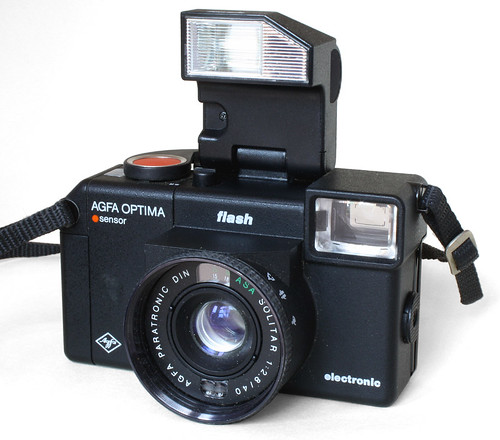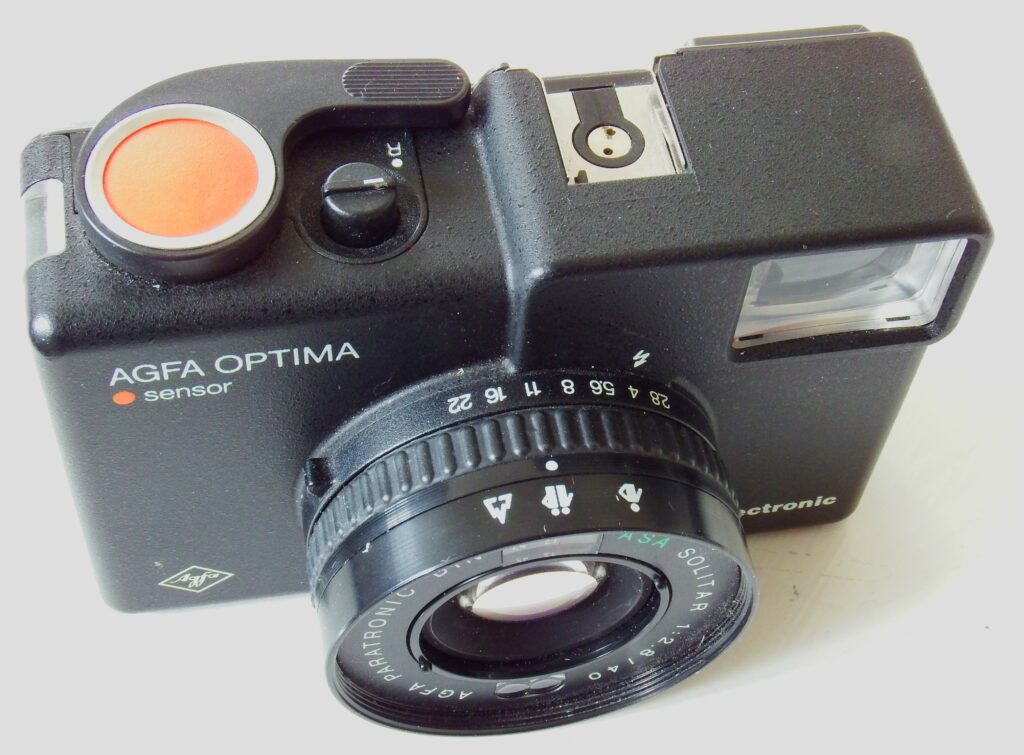I have come across many cameras through my time doing analog photography. Most of the very plasticky cameras have never really caught my interest and got my liking, but one series of cameras that deviate from that trend are the Agfa Sensor series.

Some of the things that especially has caught my interest and got me shooting with several of these cameras are their huge and very bright viewfinder, and another thing is the Solitar lenses that a lot of them have. That is a magnifient piece of optics, that perform well in most situations, at least I have been extremely satisfied with the results.
But before I reveal all the conclusions, lets delve more into the common features of the series, and of course into the specifics of the reviewed model. The name “Sensor” of the cameras come from the huge red electronic release button, and is one very characteristic feature of these otherwise completely black cameras.
The Agfa Sensor cameras come in many versions:
- Optima Sensor Electronic 335 with a 40mm f/3.5 Agnatar lens with shutter speed from 1/30th to 1/300th
- Optima Sensor Electronic 535 with a 40mm f/2.8 Solitar single coated lens with shutter speeds from 15 seconds to 1/500th
- Optima Sensor Electronic 1035 with a 40mm f/2.8 Solitar multi coated lens with shutter speeds from 15 seconds to 1/1000th plus a self-timer
- Optima Sensor Electronic 1535 with a 40mm f/2.8 Solitar multi coated lens with shutter speeds from 15 seconds to 1/1000th, and a coupled rangefinder
- Then one of the two cameras, that I own: Optima Sensor Electronic without any numbering. It has the same features as the 535 model
- Finally, the second of these, that I own: Optima Sensor Electronic Flash with a 40mm f/2.8 Solitar single coated lens with shutter speeds from 1/45th second to 1/1000th, and an added built-in flash. This model is conveniently powered by two AAA batteries.

Features that are common for the series are:
- The large viewfinder
- Stepless shutter speeds (within the overall range of the model)
- A very easy film loading system
- Respooling film with the help of a reversible film crank
- Manual focusing with the help of zones, except for the 1535 model with its coupled rangefinder
- Auto exposure
- A tiny size (104 × 69 × 56mm (W x H x D), except for the Flash model, that is somewhat larger due to both the flash and its battery compartment for the two AAA batteries
Like so many other cameras I came across these when I bought big boxes of cameras. One of the first of these I actually acquired to get a Nikon D4 digital SLR, but the photographer included some analog cameras, some old some quite recent. Among these were the Agfa Optima Sensor Flash, and a Holga N 120 that is relevant for another of my recent projects, that you can find here; Holgraphy.
At first I didn’t use the Agfa, as it was for the Nikon, I got this box of cameras, but at some point I thought why not just give it a try, and I went for a shoot in the vicinity of my home. When I developed the film, I was struck by the sharpness, contrast, and generally very pleasing look of the images. During the next months I shot a lot more, though I wasn’t to pleased with the size and design of the camera, knowing that it had a lot of sisters and brothers of a much sleeker design. Therefore, I decided to get one of these and went for the Agfa Sensor Electronic, knowing that this had the exact same amazing lens, and some further advantages with regard to the selection of shutter speeds.
This camera slipped into any small bag and accompanied me on my bike trips to work for a long time. Unfortunately, I found it had one minor flaw. When shaken on my mountain bike trips, the film advance seemed to loose grip of the film, and could even destroy the sprocket holes. The film would stay in the same position and expose the same frame multiple times, without my knowing. I still got a lot of nice images, and finally settled on not taking it on my bike trips. I’ve been using it on other trips without this issue, and I’m sure its only my copy of the camera that has this issue. The flash model has the same easy film advance system and hasn’t had this problem.
Talking of film advance and respooling we are at some of the smart features of this camera series. Often you would have to thread the film into a film take up spool and make sure, that it really was advancing properly before shooting images. In this series of cameras you just drop the 35mm film canister into the camera, push the film tip into a slot, close the camera, and you are ready to go.

Except for one of the models, the Optima 1535, there is not much help in focussing the camera, but there is zone focus, and if you look for it also a focus scale in meters and feet. The scale is not immediately visible as it is underneath the lens.
The upper side of the camera is dominated by the large and shiny red sensor release button, but it also holds a number of other features like a hotshoe, and the very smart film return feature. Initially, as there is no return spool lever, you would probably think “but how do I spool back the film to the canister after shooting?” This is solved in the most ingenious way I have come across on any camera without motor. You press down a button, and turn it to an “R” marking, and suddenly the advance lever will do as a return lever. That makes the outside of the camera much simpler and makes room for the large viewfinder, where the return lever would normally live. This is also one of the design features making the small size of the camera possible, what a brilliant idea.



No matter what other smart features a camera has, the most important is for a lot of photographers the image quality. Luckily, most of the cameras in the Optima Sensor series except the 335 model have the Solitar 40mm f2.8. With regard to sharpness, contrast, and colour reproduction this is a very fine lens despite its quite simple construction consisting of 4 elements in 3 groups. Click the images and observe the details that the lens is capable of.
Conclusion:
This camera is by its small size and remarkable features a little jewel, despite being build almost entirely of plastic it feels like high quality. If image quality wasn’t there, I would dismiss it immediately, but it is actually one of the very strong sides of this camera. And the wonderfully large viewfinder is awesome making very easy to compose your image.
Pros:
- Size (104 × 69 × 56mm (W x H x D)) apart from the flash model
- Nice and quick film loading
- Smart rewind feature
- Huge viewfinder
- Great lens (Solitar) resulting in extremely fin image quality
Cons:
- It seems the winding mechanism can fail if the camera is shaken (heavily??), though only one of my two has failed on me
This camera in any of its Solitar version comes with high recommendations from me. I’ll keep my two specimens for ever and maybe even get a 1535 to have the rangefinder.




